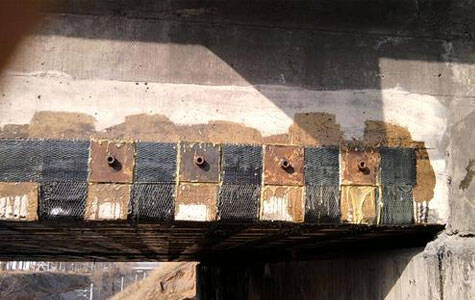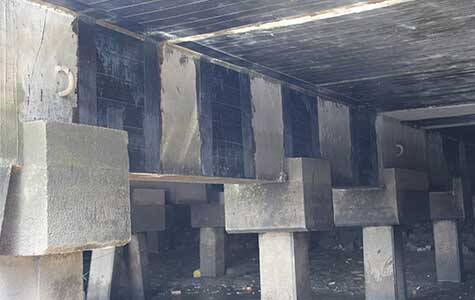Solutions
Horse Construction offers full range of structural strengthening materials with technical supports, documentation supports, products supports, project supports.
Analysis On Strengthening Concrete Structure With Unidirectional Carbon Fiber


With the emergence of new building materials, unidirectional carbon fiber cloth as a relatively new material for structural reinforcement has gradually been widely used in the construction and reinforcement of building structures. The use of resin materials to stick carbon fiber cloth on the surface of the structural member can effectively improve the strength of the structural member of the building, thereby achieving the purpose of reinforcement. This paper analyzes the construction technology of carbon fiber cloth through actual cases, introduces the reinforcement construction method and inspection results of carbon fiber cloth in detail, and judges the good effect of carbon fiber cloth on structural reinforcement.
Unidirectional carbon fiber cloth is mainly used for seismic, shear, and tensile reinforcement. This material is used together with impregnating glue to effectively improve the strength of structural members. Therefore, it has a better reinforcement effect under the conditions of protection and reinforcement, repair of components in a harsh environment, crack treatment, concrete strength lower than design value, material aging, engineering use function changes, and load increase.
Strengthening concrete structure with unidirectional carbon fiber
1. Technical preparation
When using carbon fiber cloth to reinforce reinforced concrete structural members, it is necessary to formulate the construction plan in advance, and conduct feasibility demonstration and improvement of the reinforcement plan. The reinforcement personnel need to conduct an in-depth analysis of the reinforced structural members and formulate different reinforcement treatment measures according to the actual situation on the site. At the same time, learn more about the characteristics of carbon fiber cloth, and compare and analyze the effects of different pasting methods. After a detailed and in-depth analysis, the material categories selected for the corresponding project are clarified, detailed construction methods are developed, and reinforcement design drawings are drawn.
This paper takes a power plant reinforcement project as an example to analyze the carbon fiber cloth reinforcement technology. Reinforcers need to excavate the soil around the foundation column, dig to the platform, clean up the surface of the column, and polish it into an arc. The radius of the arc should be greater than 20 mm. Use carbon fiber cloth to reinforce the position about 1 cm above the construction joint of the foundation platform.
2. Carbon fiber cloth reinforcement construction technology
Remove impurities on the surface of the component and clean it up - apply primer - levelling and repair - apply carbon fiber glue - bonding carbon fiber cloth - apply carbon fiber adhesive again - surface decoration or fire prevention treatment.
(1) Surface repair and treatment of the base layer
When reinforced concrete structural members do not meet the design requirements, they need to be reinforced according to the site conditions. According to the different construction positions of carbon fiber cloth reinforcement, the floating layer on the surface of the reinforced concrete structural member needs to be cleaned before the reinforcement treatment of the reinforced concrete structural member. Derust the exposed steel bars, and select appropriate polymer mortar to treat the components according to the concrete strength of the components. In the process of mortar treatment, it is necessary to repair the concave position on the surface of the component. Make the surface of concrete structural members smooth and effectively and clearly show impurities.
(2) Reinforcers need to formulate corresponding plans in advance for the direction of the carbon fiber cloth arrangement, the number of layers, and the choice of carbon fiber cloth thickness. Focus on the width of the carbon fiber cloth to ensure that the width of the carbon fiber cloth actually used on site is consistent with the width in the project design. After the carbon fiber cloth is determined, the impregnating resin needs to be selected, and the impregnating resin needs to be processed before sticking. The impregnating resin should be fully inspected before construction, so as to ensure that the impregnating resin selected meets the relevant requirements of the design and specifications. Reinforcement personnel need to operate strictly according to the specific operating requirements in the specification of the impregnating resin selected, and use the impregnating resin within the specified time. The mixed material only needs to be stirred once. In the process of stirring, impregnate the resin to prevent foreign matter from falling into it. At the same time, corresponding measures should be taken to prevent dust. In the process of carbon fiber pasting, the construction environment temperature needs to be strictly controlled to ensure the effect of pasting. The operator should make reasonable adjustments to the impregnating resin mixing conditions according to the site conditions, and at the same time, do not add other solvents to the impregnating resin during use.
In the process of carbon fiber cloth pasting and fixing, the surface of the concrete structure that needs to be reinforced should be painted with a uniformly mixed resin material. This operation process mainly uses brushes or spatula brushes for the treatment of the grassroots level. At the same time, the operator is required to determine the amount of brushing according to the surface roughness of the concrete structure on site.
Finally, during the pasting process, the operator needs to pay attention to the control of the overlap length of the carbon fiber cloth to ensure that the overlap length meets the requirements of the relevant specifications and meets the requirements of the design plan to prevent the carbon fiber cloth from voiding during later use. When encountering obstacles that cannot be effectively removed during the pasting process, the carbon fiber cloth should be cut off. The operator determines the location of the partition according to the site conditions, determines the location by way of wire laying, etc., and pastes the carbon fiber cloth in strict accordance with the pre-established pasting plan. At the same time, the carbon fiber cloth is pasted according to the progress of the resin coating, and it is pasted with the brush, and the pasting part cannot be disturbed within 24 hours after pasting.
3. Conclusion
Reinforcement of reinforced concrete structural members is currently the most common form of reinforcement in my country. With the continuous development of new materials, new technologies, and new processes, unidirectional carbon fiber cloth reinforcement technology is increasingly being widely used in the engineering field. Because of its good reinforcement effect, the strength of concrete structural members is improved after reinforcement, so it is worthy of our attention and research. There are many factors that affect the reinforcement effect of carbon fiber cloth during the construction process, so strict quality control of the construction process is required to achieve the desired effect.
You can find anything here you are in need of, have a trust trying on these products, you will find the big difference after that.

High strength, unidirectional carbon fiber wrap pre-saturated to form a carbon fiber reinforced polymer (CFRP) wrap used to strengthen structural concrete elements.

High strength carbon fiber reinforced polymer (CFRP) strip / laminate / plate for structural strengthening and concrete repair

High strength, unidirectional carbon fiber fabric pre-saturated to form a carbon fiber reinforced polymer (CFRP) fabric used to strengthen structural concrete elements.